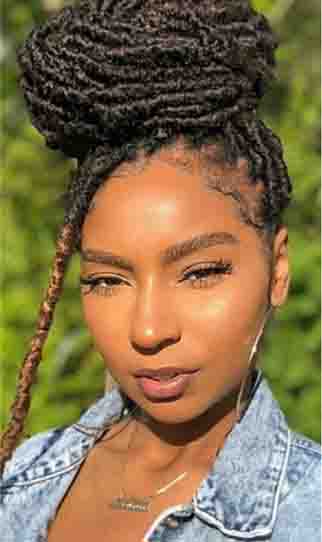Faux locs have gained widespread popularity in the hottest trends category of protective styling. This style has become the hair goal among women worldwide. But you may have some confusion regarding do faux locs damage your hair, what you should do and not do with locs, how to maintain them, etc.
No matter what length of extension you choose to protect your hair, faux locs can still cause some unavoidable damage. For example, hair fall, damages follicles, and cause pain in the head, neck, and shoulder.
But is there any way to reduce the damage of faux loc? Yes, some rules and maintenance techniques can minimize the extent of hair damage. Read along to find out the ways of protecting your style.
Do’s And Don’ts Of Faux Locs

When rocking faux locs, you need to follow some Do’s and Don’ts to maintain your protective style. Here are they:
Do’s:
- Start making your faux locs on clean and moisturized hair.
- Take your time and make faux locs with care and secure strands properly so that your locs become long-lasting.
- Make sure you hide the braid underneath completely.
- Always dry your locs after showering.
- Wash faux locs at least twice a week.
Don’ts:
- Don’t make your braid too tight; keep the braids loose enough to attach extension hair comfortably.
- Never tie your locs or make a hairstyle when your hair is damp.
- Don’t use more hair extensions than the ideal amount to wrap a single braid; otherwise, it’ll make your faux locs unbearably heavy.
- Try not to sleep by leaving your hair down under your back.
- Don’t dry your faux protective style directly under the sunlight.
- Never leave the conditioner on your locs.
- Don’t swim in highly bleached and chlorinated water.
Are Faux Locs Damaging To Your Hair?

Faux locs hairstyle can cause damage to your hair. If you make your classical braid tightly, it can create stress and tension between your hair root and scalp and eventually increase hair loss issues.
Similarly, if you attach too much extra hair to the braid, it’ll make your faux locs heavy and create too much tension between hair and scalp. This mistake will not only lead you to hair fall but also cause pain in your neck, shoulder, and especially on your head, which can be extremely painful.
Why Are Faux Locs So painful?
If locs are installed too tightly with too many added loc extensions, your faux locs will surely be painful. The extra weight of braids and braiding hair rigorously causes stress on the hair roots and eventually, damages hair follicles and causes pain.
Does Faux Locs Make Your Hair Fall Out?
Yes, faux locs can make your hair fall out due to the stress in hair roots. However, you can prevent hair fall after getting faux locs with proper care and guidance.
Do Locs Cause Baldness?
Wearing faux locs won’t make you go bald if you know how to maintain faux locs. If you neglect your own hair and don’t maintain a proper hair care routine, it can lead you to baldness indeed.
Does Goddess Locs Break Your Hair?
No, goddess locs will not break your hair. In fact, they can actually help to protect your hair from damage.
Do Distressed Locs Hurt?
Distressed locs protective styles are fashionable, no doubt. But wearing distress locs for a long time can hurt your scalp, roots, and even can cause pain in the neck and shoulder.
Are Locs Healthy For Your Hair?
When you decide on getting faux locs, it means you’re getting your natural hair into a protective style. This way, you won’t need to manipulate your own hair frequently, which means less wear and tear on hair strands. And it’ll ensure that your hair grows in a healthy and freeway.
Does Your Hair Grow With Locs?
Yes, after you get your hair braided, your hair will still grow at the same speed as without faux locks. But locs don’t have anything to do with the growth of your hair. However, your natural hair growth will give your locs additional length.
How To Remove Faux Locs?

There are multiple ways of removing your faux locs from your head. But you should remove locks in a way that ensures you keep your hair healthy and strong after removing the locs.
On the other hand, the cornrow method consists of hooking hair into the cornrow base. Therefore, the process can be time-consuming depending on your hair type but make sure you are gentle on your hair while removing them.
How To Take Out Soft Locs?
First, Take the strand of the loc and twist it in the opposite direction.
Second, Now unwrap your natural hair; you may need to do some pulling and tugging at this stage.
Third, Once you loosen the synthetic hair, pull the loc downward. Now you can see your real hair separated from the locs.
Fourth, Continue the same process to unlock all the hair strands without cutting or damaging your hair.
How To Take Out Individual Crochet Faux Locs?
First of all, remove any extra accessories from your hair so that you don’t damage your natural hair while removing the locs.
2nd, Now lose the loop of false hair from the top of your own hair.
3rd, Pull out the crochet and hair gently through the loops.
4th, Next, pull down the extension firmly and unravel your hair.
5th, After that, apply shampoo and deep conditioner to your hair and rinse hair properly.
How Do You Prepare Natural Hair For Faux Locs?

No matter whether you have curly or straight hair texture and short or long hair length, you must prepare your natural hair for getting faux locs. Generally, protective styles reduce your ability to hydrate your hair after installing the hairstyle, so it’s better to start on hydrated hair.
Here’s how to prepare for locs:
- Apply a nourishing hair mask if possible.
- Wash your hair properly with a clarifying shampoo before your install faux locs. This step is a must.
- Dry your hair completely and detangle your hair.
- After that, apply any good-quality smoothing cream and moisturizer to your hair.
- Again comb and detangle your hair, then section your hair evenly to start braiding hair.
Note: We suggest using marley hair for faux locs as this extension requires low maintenance compared to other protective styles.
Tips To Maintaining Faux Locs The Right Way
Faux locs can cause serious damage to your hair unless you maintain faux locs the way they need. Here are some tips on how to maintain faux locs in the right way:
- Purify with Shampoo: Clean your faux locs and scalp using a purifying shampoo at least twice a week.
- Rinse with Warm Water: Sometimes use warm water to wash your locs.
- Ensure Complete Drying: Allow your hair to dry completely after your shower.
- Hot Oil Massage: Apply hot oil massage using essential oils to smooth your locs.
- Moisturize and Hydrate: Moisturize and hydrate real locs or braid underneath the extension. This tip will also handle your frizz.
- Sleep on Silk: Sleep on a silk pillow cover.
- Release Tension: Always place your hair over the pillow in the opposite direction to release some tension on the hair roots.
- Scalp Massage and Blood Flow Promotion: Give your scalp a deep tissue massage at least once a month. And try to run fingers frequently through the hairlines to promote blood flow.
FAQs
It’s really hard to tell which one of these hairstyles is more damaging than the other style. Just like box braids, both of these protective style create tension between roots and scalp that leads to hair damage. But soft and butterfly locs hairstyle is pretty effective in reducing environmental hair damage.
This protective style is usually made by using yarn and synthetic hair. The best hair for faux locs are crochet hair, marley hair, human hair, or kanekalon hair. Choose one of these extensions to wrap your real lock or classic braid.
Those braids are called faux locs or fake dreads that look like real dreads. But in this hairstyle, you don’t have to waste a whole year of your life to grow the locs into your desired length. You can make faux locs by yourself at home, or you can also visit a hairdresser to braid and wrap your natural hair with extensions.
Yes, faux locs are good for your natural hair as this style can protect your hair from environmental damage and breakage of your hair. However, it would be only possible when you install the locs properly and take care of them. After getting locs, you still have to clean, condition, and moisture your hair.
No matter whether you box braids, faux locs, or any other style to protect your hair using the crochet method, you shouldn’t keep the style for more than 8 weeks. If you keep the style for a long time, it can cause some serious damage to hair that may take several months to recover from.
Usually, 6 packs of false hair are enough to cover your head for faux locs. However, if you want a fuller look or have very thick hair, you may need 6 to 9 packs of extensions to cover your real locs.
The faux locs cost depends on your hair length, braiding and installing method, and the extension type. Plus, each hairstylist will demand a different price to make faux locs. Generally, the faux loc hairstyle range between $150 to $300.
To remove buildup from faux locs, you can mix equal parts of apple cider vinegar and water and apply it to your scalp and locs. You can also use a clarifying shampoo to remove buildup.
Faux locs are a temporary hairstyle and are not meant to be kept permanently.
Faux locs should be kept in for a maximum of 8 weeks to prevent damage to your hair.
Yes, faux locs can last up to 3 months with proper maintenance.
The difference between locs and faux locs is that locs are natural hair that is matted and twisted over time, while faux locs are synthetic hair that is wrapped around the natural hair to create the locs.
The benefits of faux locs include versatility, low maintenance, and a protective style for your natural hair.
Hair can grow back from traction alopecia, but it depends on the severity of the damage and the individual’s hair growth rate.
You can wash faux locs every 2-3 weeks with a gentle shampoo and lukewarm water to prevent frizzing and unraveling.
Locs can be good for your hair as they are a protective style that can help retain moisture and promote hair growth.
Soft locs and faux locs are similar but have different textures. Soft locs are made with human hair and have a softer texture, while faux locs are made with synthetic hair and have a more coarse texture.
To keep your hair healthy with faux locs, it is essential to maintain a clean and moisturized scalp, avoid excessive pulling or tension on the locs, and use hair products that are compatible with synthetic hair.
Faux locs can cause tension on the scalp if they are installed too tightly, so it is important to make sure that they are not too tight.
An alternative to faux locs could be box braids, twists, or crochet braids.
To keep your hair moisturized in faux locs, you can use a leave-in conditioner, hair oil, or spritz your locs with a water and aloe vera juice mixture.
Good hair for faux locs can be synthetic hair that is specifically made for locs or Marley hair.
The secret to healthy locs is to maintain a clean and moisturized scalp, avoid excessive manipulation or tension on the hair, and use hair products that promote hair growth and prevent breakage.
The number of faux locs to put in your hair depends on the thickness of your hair and the desired look.
Faux locs should be left in for a maximum of 8 weeks to prevent damage to your hair and scalp.
The disadvantage of artificial dreadlocks is that they can be heavy, cause tension on the scalp, and may require a lot of maintenance.
Tight locs can cause hair loss if they are installed too tightly or left in for too long.
Locs can damage hair if they are installed too tightly or left in for too long, which can cause tension on the scalp and hair breakage.
Faux locs can cause an itchy scalp if they are not installed properly or if the scalp is not properly cleansed and moisturized.
Locs can make hair stronger by protecting it from environmental stressors and reducing the need for excessive heat styling or chemical treatments.
Soft locs are made with human hair and have a softer texture, while faux locs are made with synthetic hair and have a more coarse texture.
Faux locs can feel heavy due to the weight of the extensions used to create them. The size and length of the extensions also affect their weight. However, the weight can be reduced by using lighter hair extensions or creating smaller locs.
Soft locs can be a healthy protective style for hair when done correctly. However, improper installation or excessive tension can cause hair breakage and damage.
Whether faux locs are better than braids depends on personal preference and hair type. Faux locs can provide a more natural look and feel, while braids may be more durable and easier to maintain.
The frequency of retwisting faux locs depends on factors such as the hair type and styling technique used. Generally, retwisting every four to six weeks is recommended to maintain the style and prevent damage.
Butterfly locs, like any other protective style, can cause hair loss if installed too tightly or left in for too long. It is important to use proper installation techniques and not keep the style in for too long to avoid hair loss.
To prevent itching with faux locs, ensure that your scalp is properly moisturized and clean. You can also use scalp sprays or oils designed for protective styles to relieve itchiness.
Applying mousse to faux locs can help to maintain their shape and style, but it is important to use a lightweight, non-sticky mousse that will not cause buildup or weigh down the hair.
Verdict
From the above discussion, you now know do faux locs break your hair or not. Technically, all protective hairstyles cause some damage to your hair, but with proper installation methods and maintenance, it’s possible to reduce the damage.
Moreover, try to go for a natural look of faux style. Don’t decorate your head too much and add extensions. Also, make sure you follow the maintenance tips and leave the twists loose enough to allow your hair to grow freely.

